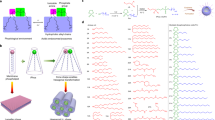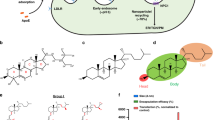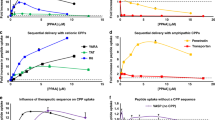Abstract
The synthesis of a series of novel cationic lipids through the systematic substitution of cholesterol derivatives that could greatly enhance the delivery and expression of plasmid DNA in vitro and in vivo is described. Two of the newly synthesized lipids, designated as NCC4 and NCC10, were chosen to be studied in detail and gave much higher levels of gene expression than that which could be obtained with some of the conventional cationic polymers and cationic liposomes. In vivo studies with both NCC4 and NCC10 also showed better ability in delivering the reporter gene to the target cells through intrasplenic injection. In addition, by varying the DNA/lipid charge ratios, NCC4 and NCC10 can withstand serum inactivation in vitro. However, this does not correlate with the corresponding increase in the level of gene expression following systemic gene delivery with NCC4 and NCC10 in vivo.
This is a preview of subscription content, access via your institution
Access options
Subscribe to this journal
Receive 12 print issues and online access
$259.00 per year
only $21.58 per issue
Buy this article
- Purchase on Springer Link
- Instant access to full article PDF
Prices may be subject to local taxes which are calculated during checkout









Similar content being viewed by others
References
Smith AE . Gene therapy – where are we? Lancet 1999 354 (Suppl.): 1–4
Anderson WF . Human gene therapy Nature 1998 392 (Suppl.): 25–30
Ledley FD . Pharmaceutical approach to somatic gene therapy Pharm Res 1996 13: 1595–1614
Romano G et al. Latest developments in gene transfer technology: achievements, perspectives, and controversies over therapeutic applications Stem Cells 2000 18: 19–39
Scherman D et al. Application of lipids and plasmid design for gene delivery to mammalian cells Curr Opin Biotechnol 1998 9: 480–485
Mountain A . Gene therapy: the first decade TIBTECH 2000 18: 119–128
Smith KT, Shepherd AJ, Boyd JE, Lees GM . Gene delivery systems for use in gene therapy: an overview of quality assurance and safety issues Gene Therapy 1996 3: 190–200
Wolff JA et al. Direct gene transfer into mouse muscle in vivo Science 1990 260: 926–932
Gilboa E . Retroviral gene transfer: applications to human therapy Prog Clin Biol Res 1990 352: 301–311
Rosenfeld MA et al. Adenovirus-mediated transfer of a recombinant alpha 1-antitrypsin gene to the lung epithelium in vivo Science 1991 252: 431–434
Miller DG, Adam MA, Miller AD . Gene transfer by retrovirus vectors occurs only in cells that are actively replicating at the time of infection Mol Cell Biol 1990 10: 4239–4242
Herz J, Gerard RD . Adenovirus-mediated transfer of low density lipoprotein receptor gene acutely accelerates cholesterol clearance in normal mice Proc Natl Acad Sci USA 1993 90: 2812–2816
Simon RH et al. Adenovirus-mediated transfer to the CFTR gene to lung of nonhuman primates: toxicity study Hum Gene Ther 1996 4: 771–780
Ali M, Lemoine NR, Ring CJA . The use of DNA virus as vectors for gene therapy Gene Therapy 1994 1: 367–384
Zhou X, Huang L . DNA transfection mediated by cationic liposomes containing lipopolylycine – characterization and mechanism of action Biochim Biophys Acta 1994 1189: 195–203
Nabel EG et al. Gene transfer in vivo with DNA–liposome complexes: lack of autoimmunity and gonadal localisation Hum Gene Ther 1992 3: 649–656
San H et al. Safety and short-term toxicity of a novel cationic lipid formulation for human gene therapy Hum Gene Ther 1993 4: 781–788
Felgner PL et al. Lipofection: a highly efficient, lipid-mediated DNA-transfection procedure Proc Natl Acad Sci USA 1987 84: 7413–7417
Gao X, Huang L . A novel cationic liposome reagent for efficient transfection of mammalian cells Biochem Biophys Res Commun 1991 179: 280–285
Hawley NP et al. Lipofectamine reagent: a new, higher efficient polycationic liposome transfection reagent Focus 1993 15: 73–79
Felgner JH et al. Enhanced gene delivery and mechanism studies with a novel series of cationic lipid formulations J Biol Chem 1994 269: 2550–2561
Solodin I et al. A novel series of amphiphilic imidazolinium compounds for in vitro and in vivo gene delivery Biochemistry 1995 34: 13537–13544
Lee ER et al. Detailed analysis of structures and formulations of cationic lipids for efficient gene transfer to the lung Hum Gene Ther 1996 7: 1701–1717
Budker V et al. Protein/amphipathic polyamine complexes enable highly efficient transfection with minimal toxicity BioTechniques 1997 3: 139–147
Kikuchi A et al. Development of novel cationic liposomes for efficient gene transfer into peritoneal disseminated tumor Hum Gene Ther 1999 10: 947–955
Choi YH et al. Characterization of a targeted gene carrier, lactose-polyethylene glycol-grafted poly-L-lysine, and its complex with plasmid DNA Hum Gene Ther 1999 10: 2657–2665
Singhal A, Huang L . Gene transfer in mammalian cells using liposomes as carriers. In: Wolff JA (ed) Gene Therapeutics Birkhauser: Boston 1994 118–142
Wheeler C et al. Converting an alcohol to an amine in a cationic lipid dramatically alters the co-lipid requirement, cellular transfection activity and the ultrastructure of DNA–cytofectin complexes Biochim Biophys Acta 1996 1280: 1–11
Lasic DD, Templeton NS . Liposomes in gene therapy Adv Drug Delivery Rev 1996 20: 221–266
Litzinger D, Huang L . Phosphatidylethanolamine liposomes: drug delivery, gene transfer and immunodiagnostic applications Biochim Biophys Acta 1992 1113: 201–227
Legendre JY, Szoka FC . Delivery of plasmid DNA into mammalian cell lines using pH-sensitive liposomes: comparison with cationic liposomes Pharm Res 1992 9: 1235–1242
Hui KM et al. Induction of alloreactive sytotoxic T lymphocytes by intra-splenic immunization with allogenic class I major histocompatibility complex DNA and DC-chol cationic liposomes J Liposome Res 1994 4: 1075–1090
Hui KM, Ang PT, Huang L, Tay SK . Phase I study of immunotherapy of cutaneous metastases of human carcinoma using allogeneic and xenogeneic MHC DNA–liposome complexes Gene Therapy 1997 4: 783–790
Bonte F, Juliano RL . Interaction of liposomes with serum proteins Chem Phys Lipids 1986 40: 359–372
Farhood H, Bottega R, Epand RM, Huang L . Effect of cationic cholesterol derivatives on gene transfer and protein kinase C activity Biochim Biophys Acta 1992 1111: 239–246
Lewis JG et al. A serum-resistant cytofectin for cellular delivery of antisense oligodeoxynucleotides and plasmid DNA Proc Natl Acad Sci USA 1996 93: 3176–3181
Li S et al. Dynamic changes in the characteristics of cationic lipidic vectors after exposure to mouse serum: implications for intravenous lipofection Gene Therapy 1999 6: 585–594
Gao X, Huang L . Cationic liposomes mediated gene transfer Gene Therapy 1995 2: 710–722
Jaaskelainen I, Monkkonen J, Urtti A . Oligonucleotide-cationic liposome interactions. A physicochemical study Biochim Biophys Acta 1994 1195: 115–123
Mortimer I et al. Cationic lipid-mediated transfection of cells in culture requires mitotic activity Gene Therapy 1999 6: 403–411
Zabner J et al. Cellular and molecular barriers to gene transfer by a cationic lipid J Biol Chem 1995 270: 18997–19007
Brunette E, Stribling R, Debs R . Lipofection does not require the removal of serum Nucleic Acids Res 1991 20: 1151
Hofland HE, Sphephard L, Sullivan SM . Formation of stable cationic lipid/DNA complexes for gene transfer Proc Natl Acad Sci USA 1996 93: 7305–7309
Yang JP, Huang L . Overcoming the inhibitory effect of serum on lipofection by increasing the charge ratio of cationic liposome to DNA Gene Therapy 1997 4: 950–960
Acknowledgements
We thank Professor Leaf Huang for his comments on the manuscript. This research is supported by grants from the National Medical Research Council of Singapore and the Singapore National Science and Technology Board.
Author information
Authors and Affiliations
Rights and permissions
About this article
Cite this article
Gao, H., Hui, K. Synthesis of a novel series of cationic lipids that can act as efficient gene delivery vehicles through systematic heterocyclic substitution of cholesterol derivatives. Gene Ther 8, 855–863 (2001). https://doi.org/10.1038/sj.gt.3301471
Received:
Accepted:
Published:
Issue Date:
DOI: https://doi.org/10.1038/sj.gt.3301471
Keywords
This article is cited by
-
Synthesis of novel porphyrin-based lipids and their antibacterial activity
Medicinal Chemistry Research (2011)
-
Lipid-based emulsion system as non-viral gene carriers
Archives of Pharmacal Research (2009)
-
Cell Biological and Biophysical Aspects of Lipid-mediated Gene Delivery
Bioscience Reports (2006)
-
Nanotechnology: Intelligent Design to Treat Complex Disease
Pharmaceutical Research (2006)



